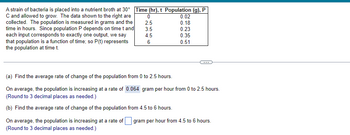A strain of bacteria is placed into a nutrient broth at 30° Time (hr), t Population (g), P C and allowed to grow. The data shown to the right are collected. The population is measured in grams and the time in hours. Since population P depends on time t and each input corresponds to exactly one output, we say that population is a function of time; so P(t) represents the population at time t. 0 NM 50 50 2.5 3.5 4.5 6 (a) Find the average rate of change of the population from 0 to 2.5 hours. On average, the population is increasing at a rate of (Round to 3 decimal places as needed.) 0.02 0.18 0.23 0.35 0.51 gram per hour from 0 to 2.5 hours.
A strain of bacteria is placed into a nutrient broth at 30° Time (hr), t Population (g), P C and allowed to grow. The data shown to the right are collected. The population is measured in grams and the time in hours. Since population P depends on time t and each input corresponds to exactly one output, we say that population is a function of time; so P(t) represents the population at time t. 0 NM 50 50 2.5 3.5 4.5 6 (a) Find the average rate of change of the population from 0 to 2.5 hours. On average, the population is increasing at a rate of (Round to 3 decimal places as needed.) 0.02 0.18 0.23 0.35 0.51 gram per hour from 0 to 2.5 hours.
Algebra & Trigonometry with Analytic Geometry
13th Edition
ISBN:9781133382119
Author:Swokowski
Publisher:Swokowski
Chapter5: Inverse, Exponential, And Logarithmic Functions
Section5.6: Exponential And Logarithmic Equations
Problem 54E
Related questions
Question
100%

Transcribed Image Text:A strain of bacteria is placed into a nutrient broth at 30° Time (hr), t Population (g), P
C and allowed to grow. The data shown to the right are
collected. The population is measured in grams and the
time in hours. Since population P depends on time t and
each input corresponds to exactly one output, we say
that population is a function of time; so P(t) represents
the population at time t.
0
NM
50 50
2.5
3.5
4.5
6
(a) Find the average rate of change of the population from 0 to 2.5 hours.
On average, the population is increasing at a rate of
(Round to 3 decimal places as needed.)
0.02
0.18
0.23
0.35
0.51
gram per hour from 0 to 2.5 hours.
Expert Solution
This question has been solved!
Explore an expertly crafted, step-by-step solution for a thorough understanding of key concepts.
This is a popular solution!
Trending now
This is a popular solution!
Step by step
Solved in 3 steps with 1 images

Follow-up Questions
Read through expert solutions to related follow-up questions below.
Follow-up Question

Transcribed Image Text:A strain of bacteria is placed into a nutrient broth at 30°
C and allowed to grow. The data shown to the right are
collected. The population is measured in grams and the
time in hours. Since population P depends on time t and
each input corresponds to exactly one output, we say
that population is a function of time; so P(t) represents
the population at time t.
Time (hr), t Population (g), P
0
2.5
3.5
4.5
6
On average, the population is increasing at a rate of
(Round to 3 decimal places as needed.)
0.02
0.18
0.23
0.35
0.51
(a) Find the average rate of change of the population from 0 to 2.5 hours.
On average, the population is increasing at a rate of 0.064 gram per hour from 0 to 2.5 hours.
(Round to 3 decimal places as needed.)
(b) Find the average rate of change of the population from 4.5 to 6 hours.
gram per hour from 4.5 to 6 hours.
Solution
Recommended textbooks for you

Algebra & Trigonometry with Analytic Geometry
Algebra
ISBN:
9781133382119
Author:
Swokowski
Publisher:
Cengage

Algebra & Trigonometry with Analytic Geometry
Algebra
ISBN:
9781133382119
Author:
Swokowski
Publisher:
Cengage